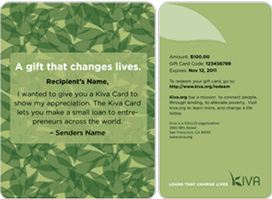The Do-Gooder’s 2011 Guide to Responsible Giving: Kiva Cards
December 8, 2011
By Kate Bennett, KF16, Perú
In the United States, it was ushered in on Friday the 25th of November in the wee hours of the morning. Here in Ica, Perú, it is manifested in the towering polyethylene Christmas tree and tinsel-adorned telephone booths in the Plaza del Sol shopping mall. Around the world, in many forms, it’s upon us: the season of giving.
This season is one of my favorites of the year, and not only because it means warbling off carols with family and friends or immersing myself in the yuletide spirit (or spirits). It’s because every year in the Bennett family, we duke it out to see just who can give the most responsibly: we exchange goats through Heifer International, carbon credits through Carbon Fund, and donations to NPR and Wikipedia.
Sure, it comes off as a competition in self-congratulatory giving. (And yes, since you ask, we are liberals from the East Coast.) But it’s also a valuable practice in stopping to recognize that we are fortunate enough to help those that need it most this holiday season. Furthermore, it’s a practice that everyone can partake in, regardless of political leaning, denomination, or country of residence.

A recent article in GOOD Magazine pointed out that, “in fact, according to a study by the Women’s Philanthropy Institute, the Americans who give away the biggest proportion of their own income [to charity] are women who make $23,509 or less a year, not ridiculously wealthy white dudes named Bill.” But this is not only because we ladyfolks with shallow pockets are good and wise and magnanimous. (Though this assuredly must play a big role.)
It’s because philanthropy doesn’t just mean a million dollar aid package, a fleet of new computers for an orphanage in Honduras, or a new well sunk in an South African village. Philanthropy can come in smaller and unconventional packages. And so it was that several years ago the Bennett family discovered the paragon of responsible giving.
Behold: the Kiva Card. It comes in red and green or blue and silver* and is the gift that keeps on giving. Benefits to you: you look like a real do-gooder, and your recipient will find you both beneficent and savvy. Benefits to them: they will get to experience the exhilaration and certain joy of picking their own entrepreneur to lend to through the Kiva website. They’ll be given an opportunity to learn about an incredible and potent organization working in a vital emerging field in development. Finally, your recipient will reap the direct monetary benefits of their borrowers’ repayments (at least, 98.93% of the time) over the next four to thirty-six months. Benefits to the world: somewhere in the sixty-one countries where Kiva works, yet another entrepreneur will be able to realize their microenterprise, and thus bolster the local economy, create jobs, and provide their families with the income and tools to move forward.
And best yet, unlike many other responsible gifts this holiday season, Kiva charges absolutely no overhead for Kiva Cards. (Unless you choose to donate on top of your $25 Kiva Card, which we could hardly blame you for.)
So what’s the drawback? You might actually look too generous and informed. And no-one likes being handed just an envelope, so be sure to find an extra big box to place your Kiva Card in before delivering it to its lucky recipient.
*Depending on what color construction paper you print it out on and what color markers you use
To give the gift of Kiva this holiday season (wink wink nudge nudge), check out Kiva Cards here!
Kate Bennett (KF16) is thrilled to be working in Ica, Peru with Kiva Field Partner Caja Rural Señor de Luren. For more on Kate’s experiences with Caja Rural Señor de Luren or life in Peru, follow her work here.
PREVIOUS ARTICLE
Women of the Year →NEXT ARTICLE
NFS Series: Women's Empowerment Part 2: Women's Empowerment and Microfinance →













